
The Oldsmobile Series 70 is a full-size midrange automobile produced by Oldsmobile between the 1939 and 1950 model years. Oldsmobiles of this time period were in an unusual "middle" position in GM's hierarchy of automobile brands. Chevrolet and Pontiac were the budget priced models, while Buick and Cadillac were the luxury brands. GM would share their "A" body platforms between Chevrolet, Pontiac, and "B" body on Oldsmobile and Buick, while leaving Cadillac on the senior "C" platform. Oldsmobiles were then branded as "luxury level" Chevrolet's and Pontiac's, while Oldsmobiles using the "B" platform were "budget priced" Buicks and Cadillacs.
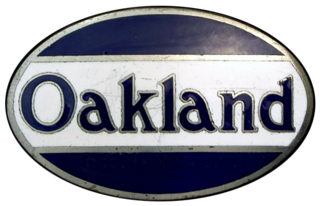
The Oakland Motor Car Company of Pontiac, Michigan, was an American automobile manufacturer and division of General Motors. Purchased by General Motors in 1909, the company continued to produce modestly priced automobiles until 1931 when the brand was dropped in favor of the division's Pontiac make.

In the late 1920s, American automotive company General Motors (GM) launched four companion makes to supplement its existing lineup of five-passenger car brands, or makes. The companion makes were LaSalle, introduced for the 1927 model year to supplement Cadillac; Marquette, introduced in 1929 for 1930 to supplement Buick; Pontiac, introduced for 1926 to supplement Oakland; and Viking, introduced for 1929 to supplement Oldsmobile. GM's fifth existing brand, Chevrolet, did not receive a companion make. With the exception of Viking, each of the companion makes were slotted below their "parent make" in GM's pricing hierarchy.

Marquette was an American automobile manufacturer established by General Motors in 1909 after the purchase of the Rainier Motor Car Company. The Marquette Company did not last long and in 1912 GM announced the company would be closed.
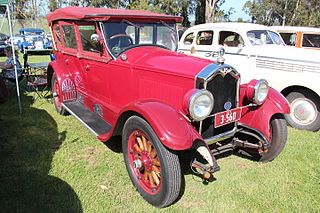
The Buick Standard Six Series 20 was manufactured by Buick at what would later become known as the Buick City factory on Hamilton Ave. in Flint, Michigan, and was the junior model to the Buick Master Six between 1925 through 1929, and shared the GM A platform with Oldsmobile, Oakland and Chevrolet. The Standard Six evolved from the earlier Buick Six when the Buick 4-cylinder was cancelled. The Standard Six was the most popular Buick sold while being more upscale to the Oldsmobile Six. It was the senior brand to Marquette under the General Motors Companion Make Program until Marquette was cancelled one year later. It replaced the earlier Buick Six that was introduced in 1916, and was replaced with the Buick Series 50. Coachwork continued to be offered by Fisher Body who was the primary supplier of all GM products at this time, and Duco automotive lacquer paint, introduced by DuPont was the first quick drying multi-color line of nitrocellulose lacquers made especially for the automotive industry.

The Chevrolet Superior Series F was launched in 1923, manufactured by Chevrolet for four years with a different series per year. The 1923 model was known as the Series B, the 1924 model was the Series F, for 1925 it was known as the Series K and the 1926 Superior was known as the Series V. It was replaced in 1927 by the Series AA Capitol. It was the first Chevrolet that didn't have a larger companion model and was the only car sold by Chevrolet in several body style configurations all supplied by Fisher Body. Each year new mechanical changes, appearance updates or optional features that became standard in subsequent years became expected of all GM products including Chevrolet. Body styles were separated into open and closed which meant closed included retractable glass in the doors and glass surrounding rear seat passengers. Standard items included tools, a jack for tire removal, speedometer, outside lockable door handles, ammeter, oil pressure gauge, dashboard light, choke pull knob, electric horn, ignition theft lock, and a two piece vertical ventilating windshield that allowed fresh air to enter the passenger compartment. Wheels were 30" and came standard with hickory wood spokes or optional pressed steel discs. For 1925, bumpers were offered optionally along with outside side view mirrors, heater for passenger compartment and a clock.
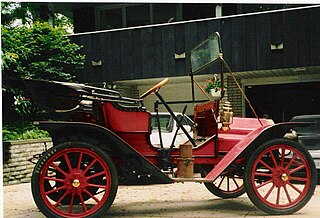
The Buick Model B was Buick's first model as an independent company, later becoming part of General Motors in 1908. It was built in Jackson, Michigan. A model B was exhibited in 1905 at the New York Auto Show as a promotion of the model C which would be the same. William C. Durant introduced the car himself at the exhibit, and took new car orders at the car show, raising sales from 37 cars in 1904 to 750 in 1905. It had a 2-cylinder, horizontally opposed engine – the world's first production OHV engine – installed lengthwise within the frame, had a planetary transmission, with a cone clutch and two forward speeds and one reverse gear. The engine was rated at 21 bhp. In later years, it was renamed as improvements were made. The chassis was shared later with the Oldsmobile Model 20 when they became a division of GM while the overhead valve engine wasn't used by Oldsmobile. It had a retail price of US$950 for the touring sedan.
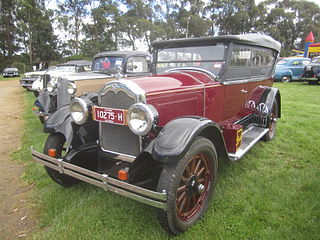
The Buick Master Six Series 40 and Series 50, based on the wheelbase used, was an automobile built by Buick from 1925 to 1928 and shared the GM B platform with the Oldsmobile Model 30. Previously, the company manufactured the Buick Six that used the overhead valve six-cylinder 242 cu in (4.0 L) engine in their high-end cars, and the Buick Four for smaller, less-expensive cars. Starting with 1918, they dropped the four-cylinder engine and designed a small six, which they called the Buick Standard Six, to replace that end of the market. They coined the name "Master Six" for the high-end cars, now powered by the 255 cu in (4.2 L) engine released the year before. The yearly changes were a result of a new business philosophy called planned obsolescence

The Chevrolet Series D is an American automobile produced by Chevrolet between 1917 and 1918. Over 4,000 Series D cars were manufactured in the 1918 model year, and it was the first Chevrolet car with a V8 engine. It was not until 1955 that Chevrolet made another V8.

The Chevrolet Series 490 is an early American automobile, made from 1915 to 1922 by Chevrolet. Introduced in June 1915, the 490 sold for $490. Chevrolet 490 was an immediate success and established the brand as a big player. The name would not denote the price for long, but it would stay low enough to take a chunk out of the Model T market. The Model T started at $495 at the time. Chevrolet was soon so profitable that Chevrolet owner Billy Durant began buying shares of GM stock with his Chevrolet stock, enough that he was able to take control of GM and merge Chevrolet with it. Electric horns were standard. And by 1921, standard equipment included a speedometer, and ammeter, dome lights, and headlight dimmers.

The Chevrolet Series AB National is an American vehicle manufactured by Chevrolet in 1928 to replace the 1927 Series AA Capitol. Documented production numbers show that 1,193,212 Series ABs were manufactured in a variety of body styles with 69,217 originating from the Oshawa factory alone. Chevrolet instituted serial number recorded on the front seat heel board on either the left or right side, using the listed numbers to designate the point of origin of the vehicle identified.

The Chevrolet Series AC International is an American vehicle manufactured by Chevrolet in 1929 to replace the 1928 Series AB National. In all, 1,328,605 Series ACs were manufactured in a range of ten body styles, with 73,918 from Oshawa. The Series AC was distinguished from the AB by the introduction of a new six-cylinder engine, the first Chevrolet with a six-cylinder since the 1915 Chevrolet Series C Classic Six. Advertised as "A Six for the price of a Four", it was only $10 more than the outgoing four-cylinder Series AB. To simplify production operations, each factory was designated one body style for national consumption and shipped by railroad to major American cities. The serial number of origin was relocated to the right body sill underneath the rubber floormat except for the roadster and phaeton, which were inscribed on the right side of seat frame. Prices listed started at US$525 for the roadster or phaeton to US$725 for the Landau Convertible.

The Chevrolet Series FA of 1917–1918 is an American vehicle manufactured by GM's Chevrolet Division. It was a replacement of the Series F which had improvements in engine capacity as well as other features. In this transformation of series, the pre-existing names of the H and F series cars, The Royal Mail and Baby Grand were dropped in favor of the names Roadster and Touring respectively. The FA Series was then replaced by the Chevrolet Series FB in 1919. Production was not interrupted while the United States entered World War I starting in 1917.

The Oldsmobile Model 30, which continued to be known as the Oldsmobile Six, was built from the 1923 through 1927. Each year it was built, it was given the suffix 30-A, 30-B, 30-C, 30-D and 30-E for the last year of production, all having been manufactured in Lansing, Michigan. General Motors used the GM A platform, shared with the Buick Standard Six and the Oakland Six, and the yearly changes were the result of a new business philosophy called planned obsolescence. The Model 30 was Oldsmobile mid-level product and introduced the flathead Oldsmobile straight-6 engine, while the Oldsmobile Model 43 with a four cylinder engine remained the entry level product. When the top level Oldsmobile Light Eight, with the flathead Oldsmobile V8 engine was cancelled in 1923, the Oldsmobile Six became the top level vehicle. It replaced the Oldsmobile Model 37 introduced in 1917, and was replaced by the Oldsmobile F-Series introduced in 1928. In 5 years, 236,474 cars were built. The growing popularity of GM's brands, like Oldsmobile, contributed to becoming the largest automobile manufacturer when sales overtook the Ford Motor Company during this time period. Coachwork for the various bodystyles were supplied by Fisher Body of Detroit, MI, and starting with the 1923 model year, all GM products adopted a shared appearance, with brand specific unique appearance features. The retail price had dropped considerably from previous years due to the popularity and affordability of the Ford Model T, with the top level sedan at US$1,095.
The Model 42 was an entry-level four seat passenger car produced by GM's Oldsmobile Division in 1914, offered as a replacement to the Oldsmobile Curved Dash runabout when it was discontinued in 1908, and was the junior platform to the Oldsmobile Six introduced in 1913. GM had acquired Elmore Manufacturing Company, Oldsmobile and Oakland Motor Car Company in 1908 and Cartercar and Rainier Motor Car Company in 1909 as their entry-level models, and Oldsmobile products were being repositioned in their new hierarchy as GM began to consolidate operations after William Durant had left.
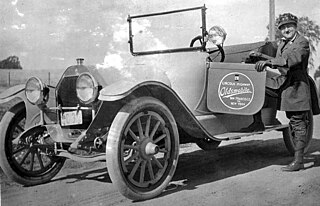
The Model 43 was an entry-level four seat passenger car produced by GM's Oldsmobile Division in 1915 and 1916, then again in 1921 and 1922. It replaced the Model 42 also known as the "Baby Olds", while the most significant improvement was a longer wheelbase shared with the Buick Series C. Until GM assumed control of Chevrolet in 1917, the previous Model 42 and the Model 43 were GM's entry-level cars which led to the interrupted production of the Model 43 as Oldsmobile was promoted as a higher content product. It was also known as the "Oldsmobile Four" and competed with the Chevrolet Series H as an entry-level model until GM bought Chevrolet. It was the junior level product to the upscale Oldsmobile Light Eight. It was Oldsmobile's last four-cylinder car until 1977 with the Oldsmobile Starfire.

The Oldsmobile Six, also known as the Model 53, 54 and 55 (1913-1915) then a brief cancellation until it reappeared as the Model 37, 37A and 37B (1917-1921) was a top level sedan along with the Oldsmobile Series 40 junior vehicle produced by GM's Oldsmobile Division and was manufactured at Lansing Car Assembly in Lansing, Michigan. It replaced the Series 28 also known as the "Oldsmobile Autocrat" and was replaced by the Oldsmobile Model 30 in 1927, and shared wheelbases with the Buick Six. It continued to use the T-head engine for two years. The various bodystyles were supplied by Fisher Body of Detroit, MI. It competed with the Chevrolet Series C Classic Six as Chevrolet was an independent company before becoming a division in 1917. Oldsmobile also shared technology with GMC for commercial and industrial products.
The Oldsmobile Series 28, also known as the Autocrat, was a mid-level four seat passenger car produced by GM's Oldsmobile Division for 1911 and 1912. It was based on the top-level Oldsmobile Limited while using a four-cylinder engine, and was manufactured in Lansing, Michigan.

The Oldsmobile F-Series was built from the 1928 through 1938 model years. The first generation continued the tradition of adding a series number for each model year; F-28, F-29, F-30 and F-31. The second generation, signified by a completely new bodystyle appearance was built from 1932 through 1938, all having been manufactured in Lansing, Michigan. 1926 saw the introduction of GM's most recognized business model, the use of common platforms shared amongst the brands, and Oldsmobile and Buick shared the GM B platform. The F-Series was shared with the Buick Master Six and was also known as the Oldsmobile Six which was introduced as a name earlier in 1913.

The Oldsmobile L-Series, or the Oldsmobile 8, was built from the 1932 through 1938. Oldsmobile hadn't offered a full-sized luxury flagship since the cancellation of the Oldsmobile Light Eight in 1923, and the Viking upscale companion brand to Oldsmobile didn't sell very well, being cancelled after two years. The 1933 model introduced a completely new body style influenced by the "streamlined" appearance, and it was shared with all GM brands due to GM's Art and Color Studio headed by Harley Earl. The appearance showed influences of Chrysler and Lincoln-Zephyr vehicles, and all Oldsmobiles were manufactured in Lansing, Michigan. Due to the popularity of the Oldsmobile F-Series, Oldsmobile recognized an opportunity to sell a similar sized alternative to the Buick Super, the Cadillac Series 355, and the "junior" companion brand LaSalle a platform the L-Series shared on the GM C platform. It was replaced by the Oldsmobile Series 90 introduced in 1938, and it was exported to Japan as a knock down kit and assembled at Osaka Assembly in Osaka, Japan.



















